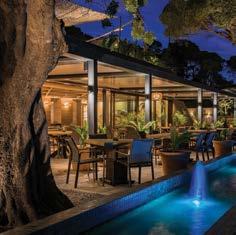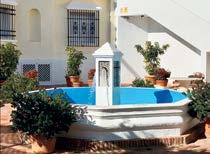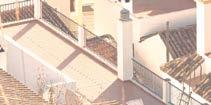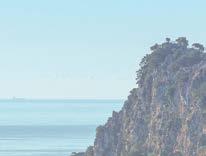All about


All about


A honeypot for the rich and famous, Benahavis offers an example of a true Spanish success story


T just seems to keep on growing. The statistics for this tiny enclave, a short drive from the snazzy nightlife of Puerto Banus and Marbella, are quite remarkable.
Long the highest-earning place in Andalucia (with an average earnings of €38,000), its population (of which 68% is foreign) by last year had soared from 7,300 residents to a healthy 9,244 since 2022. It could hit the magic number of 10,000 this Spring, predict experts.
It’s a massive amount of growth and is mostly down to digital nomads and teleworkers looking to live somewhere warm surrounded by nature and open spaces.
The free tennis, football and golf lessons for kids, plus language, yoga and pilates for adults does not do any harm either.
Benahavis really does offer something for everyone, particularly as its nearby hills have recently been officially designated the Sierra de las Nieves
National Park. Spain’s sixteenth national park, the soaring peaks often covered with snow in winter (hence the name), are some of the most amazing for hiking and bird-watching, with eagles and vultures soaring above with increasing frequency.
Best reached from the Benahavis urbanisation of La Quinta, a threehour circular walk takes you up to the famous castano santo - holy chestnut tree - that at 1000 years old is said to be the oldest in Malaga province.
Gorge
But there are many other walks right from the village, in particular down into its famous river gorge, where many people combine hiking with swimming, or up towards the stunning country retreat of the wealthy Goldsmith family, where the UK’s former Prime Minister Boris Johnson stayed three years ago. First revealed by the Olive Press, Johnson had turned up to enjoy
what Benahavis offers best: a week of hiking followed by a dabble with a paintbrush out in the open air. By coincidence his visit came at the same time as Netflix descended on the village to film a couple of scenes from the hit series The Crown. Renting out a villa in the exclusive Benahavis enclave of Zagaleta they portrayed the mid1990s holiday that Lady Diana took with her friend Jemima Goldsmith at her nearby family estate, Tramores.
The cast and crew were regularly seen around the village, both filming various scenes, as well as enjoying their time off.
“It is the best possible promotion we could have had,” explains Councillor Scott Marshall, who’s artist father David moved to Benahavis in the 1970s.
Both visits were thanks to the village’s connection to the Goldsmith family, who are heavily focussed on
Continues on next page

From previous page
protecting the local environment, in particular planting trees.
Lady Annabel Goldsmith wrote about the moment when she and her famous and talkative husband, Sir James, fell in love with the enclave. She said: “That day, as we stood on the terrace, looking at the mountains, at the amazing view, with no other sign of human habitation, and at nature at its simplest and most dramatic, Jimmy fell silent.”
In total, just 2,500 more homes
IT’s a great place to retire, explains local expat Barry Segal, a former radio DJ. “I call it the Benahavis effect and once you’ve lived here for a year you won’t want to leave.
“The people are so friendly, the climate is perfect and the place is so nice and quiet,” he continues. “Plus it is great all the free Spanish and exercise classes and even trips around Andalucia, one we recently took to Antequera.”
will be allowed inside its borders, while there are plans agreed with the Junta - to have its own 1,500-pupil school - more on that soon.
Visitors will be more impressed by the village itself, which is so nicely secluded from the buzzing Costa del Sol.
about around town.
Lungfulls of pure mountain air are on the house as you huff and puff up the cobbled streets to the top of this beautifully-kept pueblo hung with painted flower pots, and ornamented with stylish street lanterns, fountains and viewpoints, 10 to the pound. Keep an eye out for a glimpse of President Putin’s multi-towered castle at the top of one nearby hill (not that he is likely to be using it again anytime soon), while I was impressed with the electric car charger points, not to mention innovative bike repair stations

A village hike is a free history tour taking you back to Moorish times, when this former Arabic stronghold was crowned by the 11th Century Montemayor castle, overlooking vast swathes of the Costa del Sol.
The village takes its name from Havis, a Moorish prince who ruled from the castle, before his family were finally ousted, the village reconquered by the Catholic monarchs in the late 15th century.
raged on for 350 years until the village gained its independence. Near the village are a few things of note.
Village hike is a free history tour taking you back to Moorish times
It was then that war broke out between Benahavis and Marbella and
Water babies, will love the Rio Guadalmina gorge, which is one of the coolest natural attractions on the Costa del Sol.
Take a river ramble along its banks, go wild swimming in one of the deep rock pools or try canyoning along the Canon de Las Angosturas. Not for the faint-hearted, the 50-metre descent starts at Charca de las Mozas - a popular picnic spot south of the water tow -

er roundabout that’s become the unofficial swimming baths. Dive in - there’s no charge! Parts of the river were channelled by the Arabs in order to supply nearby farms and orchards. These routes have since been adapted for hiking with the addition of a suspension
bridge over the Angosturas canyon, opening up the Sendero Acequia del Guadalmina (see pic below), an easy family walking route of around four kilometres beside a watercourse dug for the farmers.
Finally, there is the Benahavis for foodies. With over a dozen restaurants and its own cookery school, it is no surprise it has been called the ‘gourmet capital’ of the Costa del Sol. There is certainly healthy competition between the many restaurants in the

MOST of the population growth in Benahavis over the last half decade has been wealthy professionals, and the majority come from abroad.
Indeed, an incredible 68% of the population is now foreign, with hundreds of digital nomads relocating here from northern Europe and the States over recent years.
But there were an incredible 101 nationalities registered on the local padron last year, with the British still the largest, counting for around 50% of the foreigners in the town and approaching 2,000 in number.
As well as the location and natural surroundings, foreigners are also drawn to the town’s high-speed fibre optics as well as its excellent sporting facilities, which are mostly free to residents.
The town is modernising and upgrading all the facilities all the time and has recently installed a full size running track.
TRANQUIL WALK: The Sendero Acequia del Guadalmina is a pleasant walk, while (right) a rare wild cabra montes SITE: of the town’s popular Romeria
NATURAL SPLENDOUR:
The arrival road is a wonderful setting for Benahavis (right)
heart of the village and each of them vie for your custom with enticing terraces facing out to the nearby hills. While they may not be free for local residents, they are anything but expensive and far better value than their nearby rivals in Marbella or Estepona.


La Taberna Fantastica was born with the idea to create a restaurant that had a unique personality Set in a century old Andalusian Cortijo in the old town of Benahavís. This space was created for you to share those fantastic moments in life with your loved ones in a charming atmosphere.
tel: 608 38 29 43 info@latabernafantastica.es Plaza de España, 8, Benahavís www.latabernafantastica.es



A unique dining experience in a inspiring location boasting stunning views of the Andalusian landscape all the way down to the Mediterranean Sea

RESERVATIONS:
+34 951 74 47 77 / +34 627 12 14 43
clive@cotorestaurante.com
www.cotorestaurante.com
Monday to Saturday: 1pm-12am
Sunday: 1pm-6pm
Ctra. de Ronda, A-397, Km. 44, 29679 Benahavís, Málaga


Flamenco Show every Friday

THEY will be descending on Benahavis from the four corners of Spain and its islands.
An incredible 55 of the country’s leading chefs are teaming up to teach local children the joys of cooking and healthy eating.
All of them with Michelin stars14 with the highest accolade of three - they will help shine a light on the small town’s giant culinary reputation.
Under the motto
‘Eating healthy is fun’, the sixth edition of Chefs for Children will feature legends, including Elena Arzak, Eneko Atxa and even Martin Berasategui, who holds a record 12 Michelin stars.
By Jon Clarkennas.
Andalucia’s finest three star whizkids Angel Leon and Paco Morales will be joined by Valencia’s superstar Quique Dacosta at the April 22 charity event at the Anantara Villa Padierna Hotel.

Sponsored by Sabor a Malaga, a grand gala dinner featuring a special menu by Malaga’s chefs will take place at the hotel that night.
Others giving cookery workshops are the celebrated team from Barcelona’s Disfrutar, Oriol Castro, Eduard Xatruch and Mateu Casa-

The Diputacion de Malaga is providing most of the local ingredients for the event, while jamon is being provided by Joselito, from Salamanca. This year’s event is raising money for charity, Autismo España, which represents nearly 175 local


groups around the country.
Mayor of Benahavis, Jose Antonio Mena, said he was ‘proud’ to be sponsoring the event again this year, after a very successful celebration last year.
The event is the perfect opportunity to showcase Spain’s most southerly region with the chefs also getting to spend a few days tasting local Andalucian cuisine.
As Asturias superchef Nacho Manzana told the Olive Press last year: “The big revolution in Spanish cuisine is taking place here in Andalucia.
“I have been cooking with amazing talented chefs from Andalucia for 25 years, but the region kept getting overlooked.
“Now, thanks to their talents, the huge variety of ingredients here and the amazing climate, it is finally happening.”
Double Michelin garlanded Navarra chef David Yarnoz, of Molino de Urdaniz, agreed: “There are so many great places to eat down here now and it’s growing by the year.”
And Valencia’s famous female


NEARLY 150 children from three local schools were given the task of creating a dozen healthy recipes for the annual Chefs for Children event in 2023. Whether shelling peanuts, making guacamole or mixing fruits for dessert, there were smiles all around.
“It’s really exciting to be here,” Adrianna Rose Morton, 6, a student at Benahavis’ Daidin College told the Olive Press.
Despite missing her two front teeth, she was beaming as she showed off her (half eaten) pudding, adding: “I’ve learnt a lot.”
The kids were helped by dozens of pupils from Benahavis’ own cookery school and Le Cordon Bleu school, in Madrid.
Organiser, Pilar Candil insisted the event had been a ‘huge success’ after raising thousands for the charity Pequeno Deseo Foundation. Much of it was thanks to the 300 guests who had paid €350 each for the large set menu at the night’s Gala Dinner.
chef Begona Rodrigo, added: “Andalucia was always the region with the most soul but the difference now is it also has great places to eat.”
Andalucia’s most recent
three Michelin star chef, Paco Morales, of Noor, in Cordoba, is proud that the ‘creative edge’ has very much come south.
“There is no doubt the chefs in Andalucia are now starting to push the boundaries,” he told the Olive Press.
His restaurant changes the menu every year, based on a different century of Spain’s culinary recipes. This year is the 18th century ‘a key century’ in Spain’s history for culinary influences.
Meanwhile Cadiz three star wun-

derkind Angel Leon explained that the ‘big boom’ over the last five to 10 years is remarkable. He believes that many wealthy gourmet tourists are specifically heading south, perhaps instead of a trip to the Basque region or Catalunya.
“This is a dream come true,” he added. “We always had the ingredients but now so many of our local chefs know how to finally use them.”





AFTER battling our way down the Rio Guadalmina, forced to leave one of our team behind, we had eventually found what appeared to be a way back to civilisation. But a series of bent metal steps jutting out of the vertical rock face had never looked less enticing, as I clutched my shaking body and scanned the cliff for an alternative.
Two-and-a-half-hours before, four of us had set

off just south of Benahavis on the river walk –sometimes called canyoning – with no idea what to expect.
Driving up the valley towards the village gives no indication of the exhilarating, some would say hard-core, experience you are about to have.
After parking our car in the village, by the water tower roundabout, we walked down to the river and initially hovered awkwardly around the first pool, uncertain whether we were in the right place.
Finally taking control in true Bear Grylls fashion, amid shouts of ‘It’s not deep enough’ and ‘You’re going to smash head-first into that rock’, I lowered myself onto a slippery waterfall and went plunging into the murky water below, screaming as I went.
As I resurfaced, shouting my approval while messily ejecting river water from my mouth, the others ditched their fears and bounded down to slide in after me, and that was it, we were off.
A series of open pools, bridged by slippery rocks and feisty little waterfalls took us down deeper into the gorge, until the sun was obscured and the November chill began to take its toll on our exposed torsos.
Little frogs and fish bounded around our ankles as we tried to locate a foothold in the riverbed, while an enormous dragonfly sent me crashing when it shocked me into losing all sense of balance.
The rocky path opened up into long, deep stretches of stream that required swimming, and we were soon engulfed in the beautifully peaceful valley.
But when we came upon a pitch black cave that had to be swum through, one of our three began to raise serious questions.
Questions like: ‘Are we sure this is even the right river?’, ‘Is there ever going to be a way out?’ and, most pertinent of all, ‘Are we going to have enough energy to go all the way back up when we eventually decide to turn around?’.
But untroubled by negative mumblings at the back, I surged forward through the narrow passageway and emerged clambering over slimy rocks, only to realise I was well and truly alone.
After what seemed like an eternity of unanswered shouts and shivering, I beat a solitary path onwards; confident I would find the end and meet the weaklings in my group back at the car.
But at that moment I was overjoyed to hear a clumsy sloshing from behind me, with only one of the team actually going back.
And 10 minutes later we found ourselves face to face with the questionable metal ladder, one missed step and we were dead.
So instead of watching my violently shivering companion slip and slide his way up the perilous cliff edge, I got on all fours and improvised, hauling myself up the rock using grubby handholds and tree trunks.
Perhaps, in hindsight, canyoning down the river is more of a hot summer’s day activity, and a brilliant one at that.
But even in the winter drizzle, it was a great adventure, and I can’t wait to do it again.



There’s a lot more in a name that first meets the eye - enter gypsy-loving Dapper Don Heredia
WHETHER it’s a glimpse as you climb the road to Ronda - or in its full glory as you enter the village - when you see La Heredia for the first time you’ll know it’s something special.
This little known pueblo, a part of greater Benahavis which sits at 300m above the Med, is striking and attractive in equal measures for its architecture and colours.
Dig a little deeper and the history behind it is just as interesting in equal measures.
The story begins when a young boy arrived in the Malaga area from Rioja
around the turn of the 19th century.
That boy became Don Manuel Augustine Heredia (1786-1846), one of the first entrepreneurs in Spain and a founding father of Spanish industrialisation. Records show he started work as a sales assistant in Vélez-Málaga at the age of 15 but by 1808 he had progressed and began to make his fortune with his first business projects trading nuts and wine with Gibraltar during the War of Independence.
In 1826 he created the company La Concepción, mining iron ore to the east of Marbella and building the first blast furnaces in Spain.

This business expanded in 1833 with the founding of the La Constancia in Malaga, one of the most advanced ironworks in the world at the time.
It was to provide timber to fuel for his ironworks that Don Manuel bought a huge area of land densely forested with pine and cork trees which includes what we now know as neighbouring El

Madroñal (named after the strawberry trees that were once common here) and La Heredia. At his peak Sr. Heredia employed more than 2,500 people and, having tried experienced Welsh miners who could not cope with the searing summer heat, a large proportion of his employees were gypsies.
Unfortunately not all gypsies were thought to be as hard-working and honest as those miners and in the mid 1800’s the Spanish government started to expel all who were not properly baptised with properly-registered family names.
PUEBLO: La Heredia has a traditional feel

And that’s when Don Manuel had the brain wave to adopt every one of his workers officially into his family. And so the story goes he
brought a priest and a notary to the offices of the Governor of Malaga, along with all of the gypsies, hundreds of them. While there he proceeded to dictate a document whereby he and his wife adopted each and every one of them, before they went on to the chapel where they were duly baptised and given the Heredia name. Then it was back to work!
Fast forward five generations to the early 1980’s and two descendents decided to create a unique pueblo named in honour of their greatgreat-great-grandfather.
STARTED IT
ALL: Big-hearted Don Manuel Heredia save the lives of hundreds og gypsies


CELEBRATED: La Heredia in a Country Life advert in 1984
identified a horseshoe shape hill with south facing panoramic views… perfect for a classic Andalucian pueblo
The building of around 50 large villas had already begun next door at El Madroñal when Francisco (Paco) Parlade, an architect, and his brother Jaime, an interior designer,

“When this pueblo is finished I would like people to look at it and wonder how many centuries it has been here,” insisted Francisco. So winding cobbled streets, plazas and fountains were introduced, alongside mahogany doors and wrought iron window rejas... and for that, like Sr. Heredia, he turned to the gypsies who scoured the local countryside. They came back with such treasures that sometimes the design of a house was changed to fit a particularly fine old door.
As Francisco would always insist, he wanted to make sure the place had class and style and didn’t just make him a small fortune. “After all, I live just up the road,” he said.
Adverts dutifully followed in upmarket British magazines like Country Life. Now, 40 years later, the pueblo is complete, having matured beautifully into its environment with a profusion of lemon trees and bougainvillea. With its elevated position just a few kilometres from the coast, La Heredia not only offers a photographers paradise, but now there are a decent number of restaurants and cafes to keep you entertained, before you take a ride further into the famous Serrania de Ronda perhaps.
Built to support Montemayor castle, Benahavis is still a highly prized location

WIts unobstructed views of over 100 kilometres of coastline and across to Africa were a prime reason why the Moors built a well fortified settlement here.
The town has its origins in the late 11th century, when it formed to support the nearby Castle of Montemayor, which was built about 100 years earlier.
Indeed, the town is named af ter Havis, the Arabic chieftain who built the castle.
Havis is Arabic for ‘son of Havis’.
The castle and town were strategically placed for the battles fought between An dalucia’s Arab kings before it eventually fell into the hands of the Catholic monarchs


PRESERVED: The Torre de la Leonera
in 1485, as part of the Spanish
At the time Benahavis was a part of Marbella, but it gained its ‘independence’ in 1572 when King Felipe II granted it a Carta Puebla and it became a town in its own right.
It remained strategically important for centuries, with its location allowing for the detection
of pirate raids long before boats landed on the shores.
During the Spanish War of Independence (1808-1814), Montemayor Castle was used by the Spanish troops as a strategic stronghold against Napoleon's army. Located 579 metres above sea level, the ruins of what was once one of Andalucia’s greatest military gems is still home to some of the most outstanding views of the Costa del Sol. Some of its walls are preserved in good condition as well as the Torre de la Reina, which contains remains of what
were once chambers and a well.
Another five towers are still standing that were built to protect the castle and village, with the Torre de la Leonera sitting in a park of the same name perhaps the best preserved.
Six towers are still standing that were built to protect the village
Spanish 20th century historian Antonio Maíz also described an entrance to a subterranean passageway, which is believed to lead all the way to the ruins of La Boveda Roman baths of San Pedro Alcántara. There are tales of treasures hidden in this passage, although none have ever been found.


Guillermo Carniceria Holandesa

Stocking a mouth watering selection of Irish black Angus beef and Spanish dry-aged beef from Galicia, TOP CUTS of American beef, as well as delicious free-range chicken, are just a portion of tasty offerings.
Famous, succulent DUTCH-STYLE SAUSAGES are a ‘must-try’, thanks to Guillermo’s own secret recipe.
CATERING for a special occasion, party or business event?
Look no further than Guillermo and his team. Choose from a delicious range of homemade dishes, including beef bourguignon, goulash, lasagne and spaghetti bolognaise. Drinks, can be selected from Guillermo’s own bodega, a selection of champagne, fine wines and cognacs from France, Spain and Italy are sure to add some fizz to your event.
TAKE AWAY a delicious homemade dish for dinner.
Choose from a wide selection including curries, goulashes, French and Spanish favourites, hearty homemade soups, as well as a range of inspiring sauces, designed to add that ‘special touch’ to dinner.
HORARIO/OPEN: Martes a Sabado / Tue to Sat 10.00 - 16.00
Tel: 952 92 74 78
email: carniceriaholandesa@gmail.com
Carretera Ronda, 43, Benahavís, Andalucia, Spain
























































































